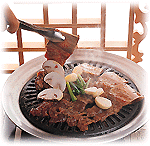The word bulgogi is commonly
translated as Korean barbecue, though it literally means "fire
meat" as bul is "fire" or gogi is "meat". Beef is most often identified with bulgogi, but
even pork, chicken, lamb, squid and octopus, for example, can be
cooked bulgogi style as bulgogi, like barbecue, is a method of cooking.
For the most common beef
bulgogi, thin slices of meat, usually tenderloin,
are marinated in a sauce made of soy sauce, sesame oil, minced garlic,
sesame seeds and other seasonings, and then cooked over a charcoal
grill, usually at the table. The grilled beef slices can be eaten
as are or wrapped in a lettuce leaf along with slices of fresh garlic
and green pepper and a dab of soybean paste, red pepper paste, or
a mixture of the two, all of which are rich in vitamins, minerals
and cancer-lighting substances.
In some restaurants, bulgogi is cooked on a dome-shaped p'an that is placed over a
charcoal brazier or a gas range. The p'an has a trough around the
edge to catch the tasty juice that cooks out of the meat so that
it can be eaten with one's rice. Bulgogi can also be cooked in a regular frying pan or on an electric
skillet but most connoisseurs prefer the traditional charcoal fire.
For pork and other types of bulgogi, a little red pepper paste is usually added to the marinade.
This gives the bulgogi a spicy taste and aroma.
Recently, people have been finding that bulgogi is not only tasty and
healthy but also very versatile. It has been adapted to today's
fast foods with some sandwich chains adding bulgogi burgers to their menus
and a number of well-known pizza restaurants even adopting it as
one of their pizza toppings. Bulgogi is an ideal picnic food and, with some slight changes
in the thickness and size of the meat pieces, it can become a tasty
hors d'oeuvre or buffet item.
|

